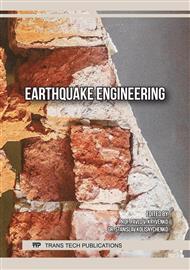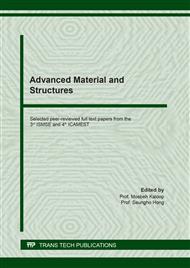[1]
R. Landolfo, L. Fiorino, O. Iuorio, A Specific Procedure for Seismic Design of Cold-Formed Steel Housing., Adv. Steel Constr. 6 (2010) 603–618.
DOI: 10.1016/j.tws.2009.02.004
Google Scholar
[2]
L. Fiorino, O. Iuorio, R. Landolfo, Seismic analysis of sheathing-braced cold-formed steel structures, Eng. Struct. 34 (2012) 538–547. https://doi.org/10.1016/j.engstruct.2011.09.002.
DOI: 10.1016/j.engstruct.2011.09.002
Google Scholar
[3]
L. Fiorino, M.T. Terracciano, R. Landolfo, Experimental investigation of seismic behaviour of low dissipative CFS strap-braced stud walls, J. Constr. Steel Res. 127 (2016) 92–107. https://doi.org/10.1016/j.jcsr.2016.07.027.
DOI: 10.1016/j.jcsr.2016.07.027
Google Scholar
[4]
L. Fiorino, V. Macillo, R. Landolfo, Experimental characterization of quick mechanical connecting systems for cold-formed steel structures, Adv. Struct. Eng. 20 (2017) 1098–1110. https://doi.org/10.1177/1369433216671318.
DOI: 10.1177/1369433216671318
Google Scholar
[5]
R. Landolfo, O. Iuorio, L. Fiorino, Experimental seismic performance evaluation of modular lightweight steel buildings within the ELISSA project, Earthq. Eng. Struct. Dyn. (2018) 1–23.
DOI: 10.1002/eqe.3114
Google Scholar
[6]
R. Landolfo, Lightweight steel framed systems in seismic areas : Current achievements and future challenges, Thin-Walled Struct. 140 (2019) 114–131.
DOI: 10.1016/j.tws.2019.03.039
Google Scholar
[7]
L. Fiorino, O. Iuorio, V. Macillo, R. Landolfo, Performance-based design of sheathed CFS buildings in seismic area, Thin-Walled Struct. 61 (2012) 248–257.
DOI: 10.1016/j.tws.2012.03.022
Google Scholar
[8]
L. Fiorino, V. Macillo, R. Landolfo, Shake table tests of a full-scale two-story sheathing-braced cold-formed steel building, Eng. Struct. 151 (2017) 633–647.
DOI: 10.1016/j.engstruct.2017.08.056
Google Scholar
[9]
G. Di Lorenzo, A. Formisano, R. Landolfo, F.M. Mazzolani, G. Terracciano, On the use of cold-formed thin walled members for vertical addition of existing masonry buildings, in: Proc. SDSS' Rio 2010 Int. Colloq. Stab. Ductility Steel Struct., 2010 945–952.
DOI: 10.1080/19648189.2014.974832
Google Scholar
[10]
G. Di Lorenzo, A. Formisano, R. Landolfo, On the Origin of I Beams and Quick Analysis on the Structural Efficiency of Hot-rolled Steel Members, Open Civ. Eng. J. 11 (2017) 332–344.
DOI: 10.2174/1874149501711010332
Google Scholar
[11]
R. Tartaglia, M. D'Aniello, A. De Martino, Ultimate performance of external end-plate bolted joints under column loss scenario accounting for the influence of the transverse beam, Open Constr. Build. Technol. J. 11 (2017) 369–383.
DOI: 10.2174/1874836801812010132
Google Scholar
[12]
R. Tartaglia, M. D'Aniello, M. Zimbru, R. Landolfo, Finite element simulations on the ultimate response of extended stiffened end-plate joints, Steel Compos. Struct. 27 (2018) 727–745. https://doi.org/10.12989/scs.2018.27.6.727.
Google Scholar
[13]
M. D'Aniello, R. Tartaglia, D. Cassiano, Experimental investigation of the inelastic tensile behaviour of non-preloadable grade 8.8 bolts, Ing. Sismica, Int. J. Earthq. Eng. 2 (2020) 92–110.
Google Scholar
[14]
P. Castaldo, E. Nastri, V. Piluso, Ultimate behaviour of RHS temper T6 aluminium alloy beams subjected to non-uniform bending: Parametric analysis, Thin-Walled Struct. 115 (2017) 129–141. https://doi.org/10.1016/j.tws.2017.02.006.
DOI: 10.1016/j.tws.2017.02.006
Google Scholar
[15]
P. Castaldo, E. Nastri, V. Piluso, FEM simulations and rotation capacity evaluation for RHS temper T4 aluminium alloy beams, Compos. Part B Eng. 115 (2017) 124–137. https://doi.org/10.1016/j.compositesb.2016.10.026.
DOI: 10.1016/j.compositesb.2016.10.026
Google Scholar
[16]
A.B. Francavilla, M. Latour, V. Piluso, G. Rizzano, Design of full-strength full-ductility extended end-plate beam-to-column joints, J. Constr. Steel Res. 148 (2018) 77–96.
DOI: 10.1016/j.jcsr.2018.05.013
Google Scholar
[17]
M. Latour, M. D'Aniello, M. Zimbru, G. Rizzano, V. Piluso, R. Landolfo, Removable friction dampers for low-damage steel beam-to-column joints, Soil Dyn. Earthq. Eng. 115 (2018) 66–81. https://doi.org/10.1016/j.soildyn.2018.08.002.
DOI: 10.1016/j.soildyn.2018.08.002
Google Scholar
[18]
F. Rizzo, G. Di Lorenzo, A. Formisano, R. Landolfo, Time-Dependent Corrosion Wastage Model for Wrought Iron Structures, J. Mater. Civ. Eng. 31 (2019) 04019165. https://doi.org/10.1061/(ASCE)MT.1943-5533.0002710.
DOI: 10.1061/(asce)mt.1943-5533.0002710
Google Scholar
[19]
A. Formisano, G. Di Lorenzo, I. Iannuzzi, R. Landolfo, Seismic Vulnerability and Fragility of Existing Italian Industrial Steel Buildings, Open Civ. Eng. J. 11 (2017) 1122–1137. https://doi.org/10.2174/1874149501711011122.
DOI: 10.2174/1874149501711011122
Google Scholar
[20]
G. Di Lorenzo, E. Babilio, A. Formisano, R. Landolfo, Innovative steel 3D trusses for preservating archaeological sites: Design and preliminary results, J. Constr. Steel Res. 154 (2019) 250–262. https://doi.org/10.1016/j.jcsr.2018.12.006.
DOI: 10.1016/j.jcsr.2018.12.006
Google Scholar
[21]
S. Costanzo, R. Tartaglia, G. Di Lorenzo, A. De Martino, Seismic behaviour of EC8-compliant moment resisting and concentrically braced frames, Buildings. 9 (2019).
DOI: 10.3390/buildings9090196
Google Scholar
[22]
R. Tartaglia, M. D'Aniello, A. De Martino, G. Di Lorenzo, Influence of EC8 rules on P-Delta effects on the design and response of steel MRF., Ing. Sismica Int. J. Earthq. Eng. 35 (2018) 104–1.
Google Scholar
[23]
R. Tartaglia, M. D'Aniello, G.A. Rassati, Proposal of AISC-compliant seismic design criteria for ductile partially-restrained end-plate bolted joints, J. Constr. Steel Res. 159 (2019) 364–383.
DOI: 10.1016/j.jcsr.2019.05.006
Google Scholar
[24]
R. Tartaglia, M. D'Aniello, G.A. Rassati, J.A. Swanson, Influence of composite slab on the nonlinear response of extended end-plate beam-to-column joints, Key Eng. Mater. 763 (2017) 818–825.
DOI: 10.4028/www.scientific.net/kem.763.818
Google Scholar
[25]
R. Tartaglia, M. D'Aniello, Nonlinear Performance of Extended Stiffened End Plate Bolted Beam-to-column Joints Subjected to Column Removal, Open Civ. Eng. J. 11 (2017) 369–383. https://doi.org/10.2174/1874149501711010369.
DOI: 10.2174/1874149501711010369
Google Scholar
[26]
CEN, EN 1998-1 Eurocode 8: Design of Structures for earthquake resistance-Part 1: General rules, seismic actions and rules for buildings, European Committee for Standardization, Brussels, (2004).
DOI: 10.3403/03244372
Google Scholar
[27]
S. Shakeel, Quantifying the seismic ductility of lightweight steel lateral force resisting systems through procedures of FEMA P695, in: 1nternational Colloq. Stab. Ductility Steel Struct. SDSS 2019, Prague, (2019).
DOI: 10.7712/120119.7348.20812
Google Scholar
[28]
I. Shamim, C.A. Rogers, Numerical evaluation: AISI S400 steel-sheathed CFS framed shear wall seismic design method, Thin-Walled Struct. 95 (2015) 48–59. https://doi.org/10.1016/j.tws.2015.06.011.
DOI: 10.1016/j.tws.2015.06.011
Google Scholar
[29]
FEMA, FEMA P695: Quantification of Building Seismic Performance Factors, Washigton, 749 DC, USA, (2009).
Google Scholar
[30]
CEN, EN 1993-1-3 Eurocode 3: Design of steel structures-Part 1-3: General rules-Supplementary rules for cold-formed members and sheeting, European Committee for Standardization, Brussels, (2006).
DOI: 10.3403/02338401u
Google Scholar
[31]
N. Yanagi, C. Yu, Effective Strip Method for the Design of Cold-Formed Steel Framed Shear Wall with Steel Sheet Sheathing, J. Struct. Eng. 140 (2014) 04013101.
DOI: 10.1061/(asce)st.1943-541x.0000870
Google Scholar
[32]
AISI-S100-16 North American Specification for the Design of Cold-Formed Steel Structural Members, American Iron and Steel Institute (AISI), (2016).
Google Scholar
[33]
AISI-S400-15 North American Standard for Seismic Design of Cold formed Steel Structural Systems, American Iron and Steel Institute (AISI), (2015).
Google Scholar
[34]
CEN, EN 1993-1-1 Eurocode 3: Design of steel structures-Part 1-1: General rules and rules for buildings, European Committee for Standardization, Brussels, (2005).
Google Scholar



